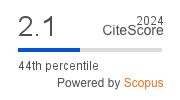Design Of Intelligent Road Eye Using AI And Machine Learning For Automobiles
DOI:
https://doi.org/10.4108/eetiot.7638Keywords:
Artificial Intelligence, Image processing, object detection, Machine Learning, Road safety, Vehicle safetyAbstract
The project aims to design an intelligent road eye by using AI and a machine learning approach to detect speedbumps and potholes on the road. The system design utilizes a YOLOv5 custom-trained model and COCO dataset in detecting the objects on the road. The system is integrated with lane detection algorithms to achieve active steering feedback and pothole avoidance. Based on the detection results, feedback will be given in the form of visual, audio, and steering angles, allowing the driver to have sufficient response time to perform braking or steering adjustments where applicable. The trained model can achieve a mean average precision value (mAP) of up to 0.995 for all classes, and a maximum detection range of 5.77m and 34.8m for potholes and speedbump respectively. The future works of the project include integrating the algorithm into the vehicle to achieve autonomous braking and active pothole avoidance with the help of sensors and cameras on the vehicle, as well as adopting augmented reality (AR) to project the visual feedback on the vehicle windscreen.
Downloads
References
[1] Ministry of Transport Malaysia, https: //www.mot.gov.my /en/land/safety/malaysia-road fatalities index.2019.
[2] S. Bhandari, A. Mhaske, S. Bhandari, A. Memon and B. Dixit. Road Conditions and Obstacles Indication and Autonomous Braking System. 3rd International Conference on Intelligent Sustainable Systems (ICISS), India. 2020; 119-124.
[3] A, P. Y., Salim, A., Dileep, A., & S, A. Autonomous Car using Raspberry PI and Ml. International Journal of Recent Technology and Engineering. (2020); 9(2): 1067–1071.
[4] Asad, M. H., Khaliq, S., Yousaf, M. H., Ullah, M. O., & Ahmad, A. Pothole Detection Using Deep Learning: A Real-Time and AI-on-the-Edge Perspective. Advances in Civil Engineering. 2022: 1–13.
[5] Dewangan, D. K., and Sahu, S. P. Deep Learning-Based Speed Bump Detection Model for Intelligent Vehicle System Using Raspberry Pi. IEEE Sensors Journal, 2021; 21(3): 3570–3578.
[6] Shahane V, Jadhav H, Sansare M and Gunjgur P. A Self-Driving Car Platform Using Raspberry Pi and Arduino. 2022 6th International Conference On Computing, Communication, Control And Automation (ICCUBEA). 2022.
[7] U. Karni, S. S. Ramachandran, K. Sivaraman and A. K. Veeraraghavan. Development Of Autonomous Downscaled Model Car Using Neural Networks And Machine Learning. 2019 3rd International Conference on Computing Methodologies and Communication (ICCMC), India. 2019; 1089-1094.
[8] Tiwari, R., Singh, D.K. Vehicle Control Using Raspberry pi and Image Processing. In: Singh, R., Choudhury, S., Gehlot, A. (eds) Intelligent Communication, Control and Devices. Advances in Intelligent Systems and Computing. 2018; Vol. 624, Springer, Singapore.
[9] B. Premalatha and C. Nataraj, “Linear Regression Based Machine Learning Model for Cataract Disease Prediction”, EAI Endorsed Trans Perv Health Tech, vol. 10, Jun. 2024.
[10] Lee, D.H., Kim, S.K., Kim, C.S. et al. Development of an autonomous braking system using the predicted stopping distance. International Journal of Automotive Technology. 2014; 15: 341–346.
[11] D. F. Llorca, V. M. Montero, M. Sotelo. Autonomous Pedestrian Collision Avoidance Using a Fuzzy Steering Controller. IEEE Transactions on Intelligent Transportation Systems. IEEE Journals & Magazine. 2011.
[12] Philip Koopman, Uma Ferrell, Frank Fratrik, Michael Wagner. A Safety Standard Approach for Fully Autonomous Vehicles. Semantic Scholar. https://www.semanticscholar.org /paper/A-Safety. 2019.
[13] Wong, A., Strous, L., Johnson, R., Grier, D.A., Swade, D. (eds). The Laws and Regulation of AI and Autonomous Systems. Unimagined Futures – ICT Opportunities and Challenges. IFIP Advances in Information and Communication Technology. 2020; 555.
[14] Nataraj, C., Karthikeyan, G., Bharathi, G.J. et al. Comparative analysis of direct coupling and MPPT control in standalone PV systems for solar energy optimization to meet sustainable building energy demands. Sci Rep 14, 22924, 2024.
[15] Ida Syafiza Binti Md Isa, Choy Ja Yeong, Nur Latif Azyze bin Mohd Shaari Azyze. Real-time traffic sign detection and recognition using Raspberry Pi. International Journal of Electrical and Computer Engineering (IJECE). 2022; 12(1):331-338.
[16] Aditya Anand, Rushiraj Gawande, Prathamesh Jadhav, Rima Shahapurkar, Anjali Devi and Nikhil Kumar Anand, A. Intelligent Vehicle Speed Controlling and Pothole Detection System, 6th International Conference on Energy and City of the Future (EVF’2019). 2020.
Downloads
Published
Issue
Section
License
Copyright (c) 2025 Chandrasekharan Nataraj, Lawrence Wong Ming Wei, Mukil Alagirisamy, Sathish Kumar Selvaperumal

This work is licensed under a Creative Commons Attribution-NonCommercial-ShareAlike 4.0 International License.
This is an open-access article distributed under the terms of the Creative Commons Attribution CC BY 4.0 license, which permits unlimited use, distribution, and reproduction in any medium so long as the original work is properly cited.




